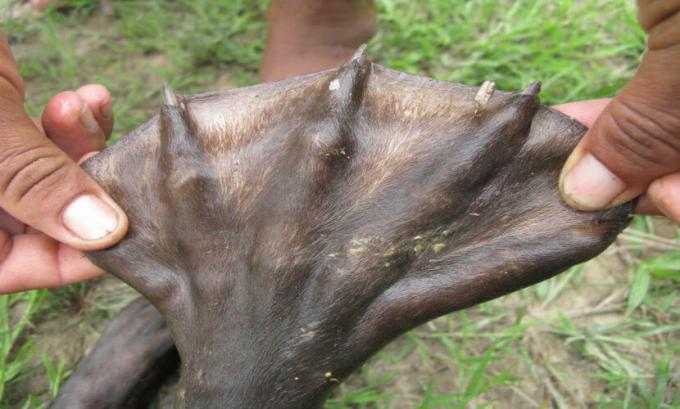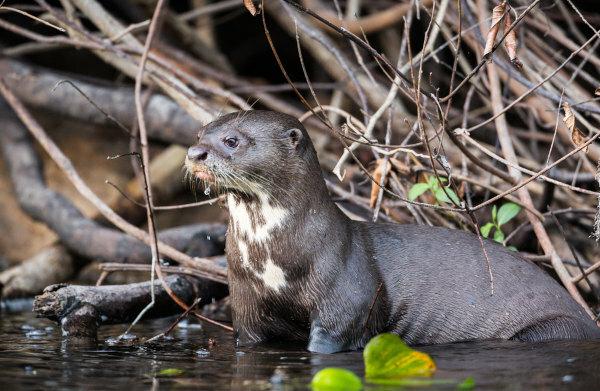THE otter (Pteronura brasiliensis), also known as giant otter, it is a mammal carnivore belonging to family Mustelidae, which is the largest and most diverse family of carnivorous animals, and subfamily Lutrinae, of the otters.
where and how they live
The otter has a distribution across South America, being found in countries like Brazil, Bolivia, Peru, Paraguay, Venezuela, Ecuador, among others. the otter inhabits freshwater environments, like rivers of slow currents, streams, lakes and its margins. They usually look for places where these margins present less slope and the vegetationé denser, in which they can build their lairs.
in addition to burrows, the otter too build latrines, in which he fulfills his physiological needs, and also campsides, which are areas built in shaded regions and close to eating areas, serving for rest and demarcation of territory.
The otter is an animal that live in groups. These family groups consist of up to 15 members and have a dominant couple. Yet, demarcate their territory through the campsides and the latrines, using odors and also from vocalization.
Know more:The competition between animals
Features
THE otter It's an animal mammal and, as such, it presents some specific characteristics of the group, such as the fact that it is an animal endothermic, to introduce mammary glands it is a fur covered body. Here are some more characteristics of the otter:
elongated body that can reach 1.8 meters and weigh about 32 kg;
long, flat tail that aids in swimming;
interdic membranes on the feet, that is, membranes between the toes that also help in swimming;
brown coat with a white irregular patch on the neck, among other features.

The otter has interdigital membranes between its fingers that help it during swimming.
food
the otter can be very selective with their food at certain times of the year, when, for example, there is greater abundance of food. At other times, it ends up being opportunist, thus varying their diet.
the otter feeds mainly on fish, and some invertebrates, like molluscs and crustaceans, in addition to small vertebrates, like some mammals and birds.
By feeding mainly on fish, the otter often ends up becoming victim of fishermen, as they believe that they hinder them in their activity.

The giant otter is a carnivorous animal that has fish as its main food.
Know more: Feeding the animals
reproduction
The otter usually reproduces, once a year, producing a litter with a maximum of six puppies. However, the average of puppies by pregnancy it's from two individuals.
The otter's first gestation occurs around the four years old. The gestation time is about 70 days. The otter cubs are totally dependent on the mother and only come out of the burrow after six weeks of life. They breastfeed until they are nine months old and at 10 months they start hunting with their parents.
By age two and a half, they can break away from their initial group to form their own group. In some studies, however, dispersion was observed within less than one year of life.

Although similar, the giant otter and the neotropical otter show differences, both physical and behavioral.
Know more: animal reproduction
Differences between giant otter and neotropical otter
The giant otter and the netropical otter (longicaudis otter), although quite similar and often found inhabiting the same environments, are animals that present significant differences not only physical but also behavioral. Which allows both to live in the same place, without a large competition between them.
Here are some differences between the two species:
Otter (Pteronura brasiliensis) |
Neotropical Otter (Otter longicaudis) |
It can reach 1.8 meters in length and weigh around 32 kg. |
It can reach 1.5 meters in length and weigh around 15 kg. |
It lives in family groups with the presence of up to 15 individuals. |
It is a solitary animal, and can sometimes be observed with the young or in a couple, especially in the reproductive season. |
Has daytime habits. |
Has nocturnal habits. |
It is generally found living in larger aquatic environments. |
It is usually found inhabiting smaller water bodies. |
Want to know more about otters? Then read our text: Otter: characteristics, reproduction, extinction and curiosities
Extinction
The otter has been suffering a declining population for decades. A few years ago, the biggest threat was hunting, both for the sell your skin as for the creation of this one in captivity.
Currently, what is threatening the populations of otter remaining are mainly the environmental degradation and fragmentation, through the contamination of water bodies with mercury and pesticides, for example; and the construction of hydroelectric projects.
Hunting is still a problem for the otters, as well as the conflict with fishermen who kill them, as mentioned above, due to the dispute for fish. In addition, the otters have been suffering from diseases, probably transmitted by domestic animals.
Currently, the otter is classified, according to The Red List of Endangered Species, of the International Union for the Conservation of Nature and Natural Resources (IUCN), likein danger. It is important to highlight that, in some regions of Brazil, they are currently extinct, as in Atlantic forest, being mostly found in the Amazon and wetland.
Read too:Endangered animals
Curiosities
 |
The giant otter has an individualized white marking on its neck, which differentiates it from other family members Mustelidae and other members of your group. |
In nature, it lives for about 11 years; in captivity, a longevity of about 20 years has been observed. |


